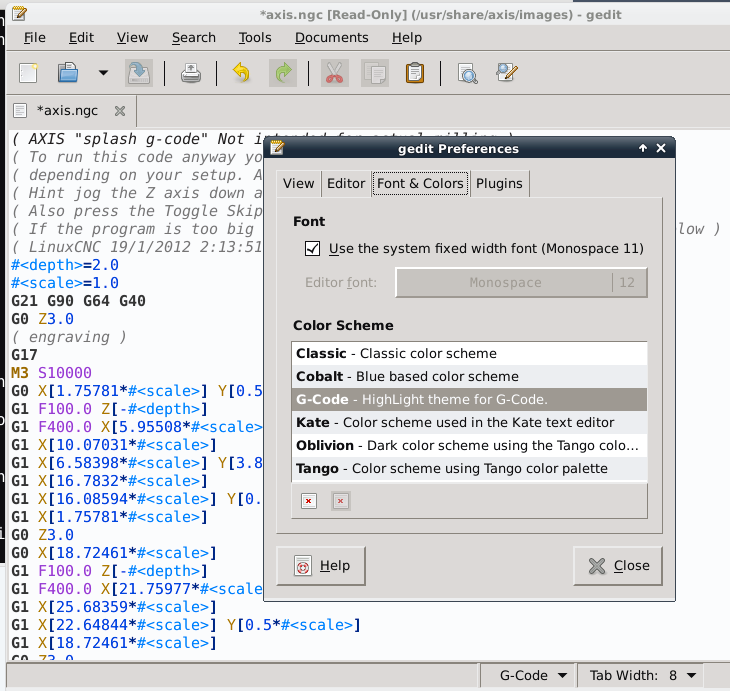

- #CTAGS GEDIT HOW TO#
- #CTAGS GEDIT INSTALL#
- #CTAGS GEDIT UPDATE#
- #CTAGS GEDIT SOFTWARE#
- #CTAGS GEDIT CODE#
That’s all there is to it! If you want to learn more about environment variables, make sure to check out my post on how to create your own custom environment variables. Lastly, if you click on Edit text, it will load a dialog where you can edit the Path variable using the old interface where all the paths are listed in one text box. The one that shows up higher in the list will be run when you type in the command. This can also come in handy if you have multiple versions of the same command in different paths and need to have one run instead of the other. If you want your executable to be found faster, just move that path up to the top of the list. When you type a command at the command prompt, Windows has to search through each directory stored in the PATH variable to see if that executable exists or not. Note that you can also move items up and down on the list. You can also delete paths using the Delete button. To edit any path, simply select it and then click on the Edit button. If you prefer, you can also click Browse and then navigate to the desired path. If you know the path, simply type it in or copy and paste it. To add a new path, simply click on New and it’ll add a new line to the bottom of the list. As you can see, Node.js and Git already added their paths so that I can run Git commands and Node.js commands from anywhere while in the command prompt. On the Edit environment variable dialog, you’ll see a list of all the paths that are currently in the PATH variable. If you need it to work across the computer system regardless of which user is logged in, then edit the system variable.
:max_bytes(150000):strip_icc()/linux-search-gedit-3922a43c94ea49bd8d0cbeac0d1dc93c.jpg)
If you only need the commands for your own user account, then edit the user variable. Both lists have the PATH variable, so you have to decide which one to edit. On the Environment Variables dialog, you’ll see two sets of variables: one for user variables and the other for system variables.
#CTAGS GEDIT INSTALL#
In conclusion, we have discussed how to install gedit in Ubuntu 20.04 LTS release.This will bring up the System Properties dialog, which should already be open to the Advanced tab. Go ahead and click on the Environment Variables button at the very bottom. Lastly, the package can be accessed from our Systems’ main Menu or terminal (issue gedit in terminal to run the application). This will also install necessary dependencies (if any).

sudo apt updateĪnd, to install gedit – issue the following in terminal, sudo apt install gedit FuncBrowser GEdit Plugin GEdit function browser plugin currently provides : 1) CTags frontend for sources files parsing (v0.1) 2) Bookmarks management for an easier navigation (v0.2) P.I.G.
#CTAGS GEDIT UPDATE#
Therefore, we need to first update Ubuntu repository to make the latest version of package available. A gedit plugin to encode and decode highlighted text to various formats e.g. Since the package is already available in standard Ubuntu repository. In case you don’t have one, then contact your System Administrator for assistance. Note: Following operations would require you to have superuser privileges. We can install gedit through apt ( Advanced Packaging Tool). It supports syntax of numerous languages like Java, HTML, Python, C, C++ etc. git clone cd gitv sh install.sh On windows machines, use installwindowsmsysgit.sh. Gitv will be installed locally in your /bin folder. sudo apt-get install exuberant-ctags Clone the repository anywhere, then run install.sh. And, at the time of writing the article, latest stable release is 3.36.1. Install exuberant-ctags to generate TAGS and use code-browsing in vim.

The package was first released on February 12, 1999. In this article, we would discuss how to install gedit in Ubuntu 20.04 LTS release. If it is red - check gedit version (current master branch requires 3.14+) and also run gedit from command line to see errors in the console. Then, you will have to install gedit separately. cd /.local/share/gedit/plugins/ git clone Then start gedit and click 'Preferences'->'Plugins' and check 'gtagJump' The plugin should be ticked then (not red). To make sure you have ctags correctly installed, issue the following command: ctags -version Make sure that you see Exuberant Ctags in the version output.
#CTAGS GEDIT SOFTWARE#
Exuberant Ctags is avaialable in the software repository for many distributions.
#CTAGS GEDIT CODE#
But, if you prefer to work with gedit and have some other Desktop Environment installed. The Gedit Source Code Browser plugin uses Exuberant Ctags to parse symbols out of source code. If you have installed GNOME Desktop Environment then, gedit comes installed as default.


 0 kommentar(er)
0 kommentar(er)
